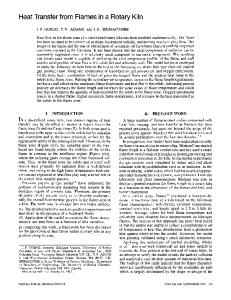Fullerenic nanostructures in flames
- PDF / 939,967 Bytes
- 7 Pages / 612 x 792 pts (letter) Page_size
- 103 Downloads / 317 Views
MATERIALS RESEARCH
Welcome
Comments
Help
Fullerenic nanostructures in flames K. Das Chowdhurya) Department of Materials Science and Engineering, Massachusetts Institute of Technology, Cambridge, Massachusetts 02139
Jack B. Howard Department of Chemical Engineering, Massachusetts Institute of Technology, Cambridge, Massachusetts 02139
John B. VanderSande Department of Materials Science and Engineering, Massachusetts Institute of Technology, Cambridge, Massachusetts 02139 (Received 4 May 1995; accepted 22 August 1995)
High resolution transmission electron microscopy (HRTEM) was used to characterize nanostructures in soots produced in flames of benzene, acetylene, or ethylene premixed with oxygen and an inert diluent gas. The nanostructures ranged from ,2 nm to ,30 nm in size with a hollow core measuring about ,1 nm to ,10 nm in diameter and containing 5 to 20 shells. The shapes of the nanostructures included spherical, spheroidal, tubular, and trigonous.
I. INTRODUCTION
Since the spectroscopic detection of C60 in carbon vapor by Kroto et al.1 and subsequent production of C60 in gram quantities by Kratschmer et al.,2 a great deal of research on fullerenes has concentrated on soots produced by the graphite arc discharge method.3–5 In this method, an arc discharge between two graphite rods in an inert gas atmosphere is operated in a reaction chamber. Gram quantities of C60, C70, and higher fullerene molecules deposit with soot on the walls of the reaction chamber and the cathode graphite rod.2 Nanotubes are also found in the deposits on the cathode graphite rod.3 Pyrolysis of hydrocarbons has also been employed for production of nanotubes and commonly observed nanostructures.6 The pyrolysis technique bears some resemblance to the flame synthesis technique we employed for nanostructure production7,8 in that the same types of hydrocarbons, e.g., benzene and acetylene, and a similar temperature regime are generally used. In this paper we report the observation of nanotubes and other nanostructures with a variety of shapes and sizes, synthesized in flames of benzene, acetylene, or ethylene premixed with oxygen and an inert diluent gas. These flames also produce C60, C70, and other higher fullerene molecules.7 High resolution transmission electron microscopy (HRTEM) was employed to characterize the nanostructures obtained in our experiments. The results show that nanotubes with a few to several
a)
Current address: Intel Corp., 4100 Sara Road, Rio Rancho, New Mexico 87124. J. Mater. Res., Vol. 11, No. 2, Feb 1996
http://journals.cambridge.org
Downloaded: 13 Mar 2015
shells, and different cap structures, and nanoparticles with spherical to polyhedral shapes and various core diameters, numbers of shells, and sizes can be produced by this technique. II. EXPERIMENTAL A. Combustion experiments
The combustion equipment included a burner in a low pressure chamber fitted with ports for feed and exhaust streams, electrical ignition, and sampling probes, and windows for visual observation and optical monitoring of the fl
Data Loading...











